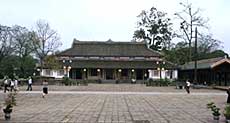Japan's Waseda University and the Hue Monuments Conservation Centre have completed work on a scaled down replica of Hue Citadel's Can Chanh Palace.
 The wooden model will assist in the rebuilding of the palace, which was originally built in 1804 under the reign of King Gia Long before it collapsed during the war in 1947.
The wooden model will assist in the rebuilding of the palace, which was originally built in 1804 under the reign of King Gia Long before it collapsed during the war in 1947.
Japan provided nearly US$10 million to build the wooden replica of the palace, which is scaled down to a ratio of 1:10.
The project is part of a program that begun in 1998 to research and preserve the historical and cultural heritage of the former royal capital city of Hue.
To work on the preservation of the palace, experts from Vietnam and Japan have to rely on political and historical documents dating back to the Nguyen dynasty, while also using black and white photos taken in early 20th century and measurements of the remaining palace foundations.
They also had to research the construction techniques used to build the palace and interview traditional artisans and elderly people who saw the actual palace before it was destroyed.
Phan Thanh Hai, the Hue Monuments Conservation Centre's director, said the project was of great importance to the city.
"We wish to restore the entire palace and expect to restore not only an architectural work but also a cultural icon of Hue city," he said.
Experts will continue to discuss ways to restore the palace in a project that has a US$32 million price tag and is expected to be completed in 2015.
The 1:10 scale replica of Can Chanh Palace is on display at a showroom behind the Duyet Thi Duong Royal Theatre in Hue Citadel, along with information on the restoration project including file photos, technical drawings, 3D images and documentary films about the work.
The palace was a venue for the King to host important ceremonies and festivities, and where he convened his court and received foreign dignitaries. It was the Forbidden Citadel's largest and most beautiful palace.